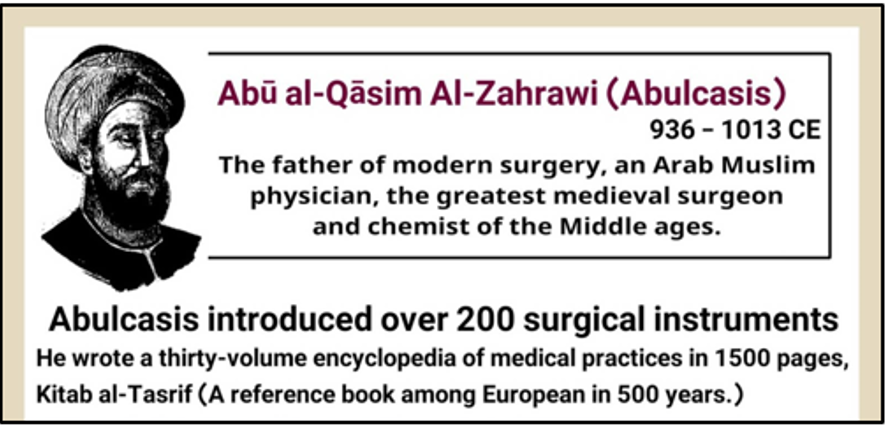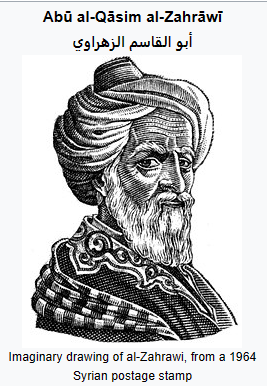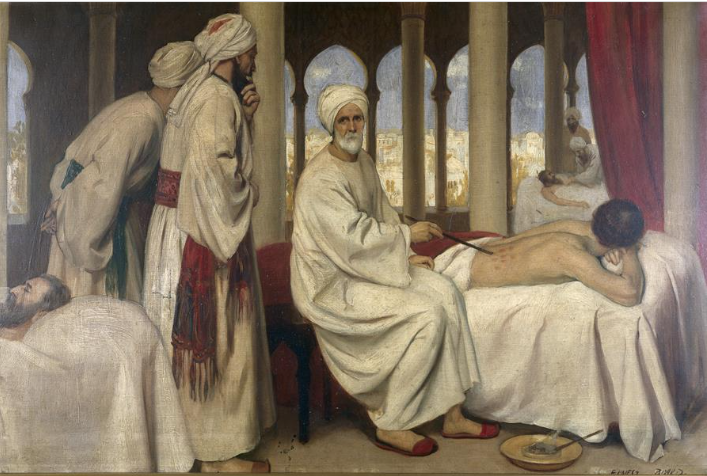 By Neenah Payne
By Neenah Payne
Ibn Sina/Avicenna: Founder of Western Medicine explains that we are told that Hippocrates (450 BCE to 380 BCE), a Greek physician, was the founder of Western medicine. Doctors today take “The Hippocratic Oath” which commits them to “First, do no harm”. However, the amazing book 1001 Inventions: The Enduring Legacy of Muslim Civilization explains that during the Middle Ages, Christians saw illness as a curse by God and resorted to prayer as the only hope for cures.
Few Americans or Europeans have heard of Abu al-Qasim Khalaf ibn al-Abbas Al-Zahrawi (also known by his Latinized name Albucasis) circa 936-1013 AD, an Arab doctor in Spain. He is considered the greatest medieval surgeon of the Islamic world and the Middle ages, and has been described as the Father of Surgery.
Albucasis’ principal work was the Kitab al-Tasrif (The Method of Medicine), a 30-volume encyclopedia of medical practices. The surgery volume became the standard text in Europe for the next 500 years after Gerard of Cremona translated it from the Arabic in the mid-late 12th century. The encyclopedia consists of 30 chapters which cover topics such as the doctor–patient relationship, areas of medical specialization, nutrition, the link between diet and disease, diagnosis by examination, pharmacology, and the classification of diseases and their symptoms.
In the last section which deals with surgery, al-Zahrawi explains that the surgeon requires knowledge from all other medical areas before operating. The book contains diagrams and illustrations of the medical and dental tools al-Zahrawi used, some of which he devised.
Al-Zahrawi’s pioneering contributions to the field of surgical procedures and instruments had an enormous impact in the East and West well into the modern period. Some of his discoveries are still applied in medicine today. He was the first physician to describe an abdominal pregnancy, a sub type of ectopic pregnancy, and the first physician to identify the hereditary nature of hemophilia.
Al-Zahrawi/Abulcasis
Abu Al Qasim Al Zahrawi (Albucasis): Pioneer of Modern Surgery
Abu Qasim Khalaf Ibn Abbas Al Zahrawi, known in the West as Albucasis or Zahravius, was born in 936 AD in Al-Zahra’, a suburb, six miles northwest of Cordoba, the capital of Muslim Spain (Al-Andalus). His ancestors were from the Al Ansar tribes of Al Madina Al Munawwarah who came from the Arabian peninsula with the Muslim armies which conquered and lived in Spain. Al-Zahrawi traveled rarely, and spent most of his life in his hometown as a practicing physician-pharmacist-surgeon.
He served as the court physician to Caliph Al-Hakam-II, at a period considered as the “Golden Age” of Arab Spain when natural and mathematical sciences reached their peak. After a long and distinguished medical career, he died in 1013 AD at the age of 77.
Around the year 1000 AD, he wrote his famous book “Al Tasreef Liman ‘Ajaz ‘Aan Al-Taleef”, (The Clearance of Medical Science For Those Who Can Not Compile It). It was a summation of about fifty years of medical education, training, practice and experience. The thirty volumes of the medical encyclopedia covered various aspects of medical knowledge. In addition to sections on medicine and surgery, there were sections on midwifery, pharmacology, therapeutics, dietetics, psychotherapy, weights and measures, and medical chemistry.”
In Al-Tasreef, three chapters were devoted to surgery.
Some of the procedures and techniques detailed in these chapters include the following:
- Surgery of the eye, ear, and throat. He fully described tonsillectomy and tracheostomy.
- He devised instruments for internal examination of the ear.
- He devised an instrument used to remove or insert objects into the throat.
- He described how to use a hook to remove a polyp from the nose.
- He described the exposure and division of the temporal artery to relieve types of headaches.
- He utilized cauterization, usually to treat skin tumors or open abscesses. He applied cauterization procedure to as many as 50 different operations.
- Application of ligature for bleeding vessels and internal stitching utilizing catgut. He preceded the famous French military surgeon Ambroise Pare (1510–1590), claimed to be the first European to utilize sutures, by five centuries.
- Treatment for anal fistulas.
- Setting dislocated bones and fractures. His method for setting and reducing a dislocated shoulder was centuries before Kocher introduced his similar technique to European medicine.
- Removal of urinary bladder calculi. He advised that the treating physician has to insert a finger into the rectum of the patient, move the stone down to the neck of the bladder, then make an incision in the rectal wall or the perineum and remove the stone.
- He devised instruments for inspection of the urethra.
- He is credited to be the first to describe ectopic pregnancy.
- He devised several dental devices and artificial teeth made of animal bones.
Al Zahrawi is considered the father of operative surgery. He is credited with performance of the first thyroidectomy. The last chapter of his comprehensive book, named “On Surgery”, was dedicated to surgical instruments. He introduced over 200 surgical tools, a staggering number by all standards. He gave detailed descriptions of for using probes, surgical knives, scalpels, and hooks. He also devised and invented surgical scissors, grasping forceps and obstetrical forceps. His illustrations of surgical instruments were the earliest intended for use in teaching and in methods of manufacturing them.
Abdel-Halim et al gave a detailed study of Al Zahrawi’s technique of cystolithotomy after inventing operative instruments not known in the Greco-Roman era. They reviewed his operative technique in women, his recommendations of two-stage operation in complicated cases and his contributions to lithotripsy by introducing a crushing forceps (Al-Kalaleeb forceps) and a driller fragmenting forceps (Al-Mishaab) to remove impacted stones.
Al Zahrawi contributed early descriptions of neurosurgical diagnoses and treatment including management of head injuries, skull fractures, spinal injuries and dislocations, hydrocephalus, subdural effusions, headache and many other conditions. He described vividly a case of hydrocephalus due to congenital defect of drainage of cerebrospinal fluid: “I have seen a baby boy whose head was abnormally enlarged with prominence of the forehead and sides to the point that the body became unable to hold it up”.
In addition, he made significant contributions to pediatric surgery. In addition to his description of hydrocephalus, he described harelip, adenoids, ranula, imperforated external urinary meatus, perforated anus, hermaphrodites, gynecomastia, supernumerary and webbed fingers. He was the first to describe in detail the medical aspects of hemophilia.
His medical writings were highly regarded in the West particularly after being translated by Gerard of Cremona, Rogerius Frugardi, Ronaldus Parmensis and others. His surgical teachings were the most advanced in the Middle Ages until the thirteenth century.
Al-Tasreef was an essential component of the medical curriculum in European countries for many centuries. The famous French surgeon Guy de Chauliac (1300–1368) quoted him over 200 times in his book appended its Latin edition to his own book on surgery. Several editions of this book (surgical chapters) were published including one at Venice (1497), at Basel (1541) and at Oxford (1778).
Finally, he emphasized child education and behavior, school curriculum and academic specialization. He advised that gifted and intelligent students be encouraged to study medicine after completing their primary education in language, grammar, mathematics, astronomy, and philosophy. This article is just a glimpse of the medical and surgical contributions of this great Arab physician from Andalus to the world.
Al-Zahrawi the Surgeon (1001 Inventions) 1/22/18
Short clip from the film ‘1001 Inventions the and Library of Secrets‘ with actor playing 10th century surgeon Al-Zahrawi who pioneered many medical innovations in early Muslim Civilisation – A golden age of science and medicine.
1001 Inventions: The Enduring Legacy of Muslim Civilization says:
If we journeyed back to the tenth-century southern Spain, we could look over the shoulder of a cutting -edge surgeon called Abul Qasim Khalaf ibn al-Abbas Al-Zahrawi, a man known in the West as Abulcasis. He would have already written Al-Tasrif, his medical encyclopedia, in which he included a treatise called On Surgery, which introduced a staggering collection of more than 200 surgical tools.
Apart from some sketches of instruments carved in ancient Egyptian tombs, this may have been the first treatise in the history of medicine to illustrate surgical instruments. In fact, their design was so accurate that they have had only a few changes in a millennium, and it was these illustrations that laid the foundations for surgery in Europe. So, rather than unsophisticated tools, surgical instruments from Muslim civilization bear much resemblance to those we still use today.
Al-Zahrawi, a surgeon and scholar who lived in Spain at the height of Muslim civilization developed and used more than 200 medical instruments, many of which we still know today. Born in Cordoba in 936, A-Zahrawi, known as Abulcasis in the West, was a physician who carried out hundreds of operations and treatments during his lifetime, developing new techniques and treatments with which to improve his patients’ prospects.
Al-Zahrawi wrote eyewitness accounts of his work and that of his peers in a 30-volume compendium called Al-Tasrif, which covered a huge range of medical situations, dental, and surgical techniques. His writings also covered drug remedies based on mineral substances, herbs, and animal products. The book was the first to illustrate surgical instruments, showing sketches of their form and describing how and when each one should be used.
One of Al-Zahrawi’s most memorable innovations was the systematic use of catgut for stitching a patient internally after surgery – as surgeons still do today. This idea, along with many others that Al-Zahrawi proposed, still bears a strong resemblance to the way moder medicine works.
Al-Zahrawi’s innovations and observations spread into Europe when Al-Tasrif was translated into Latin by Gerard of Cremona, influencing medical practice right up to the Renaissance. Along with other medical writings from Muslim civilization, it was used as a manual for surgery in medical schools for centuries.
How Al-Zahrawi Revolutionized Surgery
How a 10th-century Muslim surgeon revolutionised surgical procedures
The video below discusses the amazing contributions of the Father of Surgery al-Zahrawi. He wrote 30 books that were the foundation of Western medicine – including surgery, dentistry, and drugs. They included drawings of over 200 surgical tools he invented and their uses which are used today with only slight modifications. There was no comparable book before his.
Muslim hospitals were free and very clean. The video shows that as patients left, they were given a change of clothes and enough money to survive on so they didn’t have to work for a while.
The Greatest Surgeon of The Middle Ages – Al Zahrawi
Abū al-Qāsim Khalaf ibn al-‘Abbās al-Zahrāwī al-Ansari was born in the city of Azahara, 8 kilometers northwest of Cordoba, Andalusia. He lived most of his life in Cordoba. It is also where he studied, taught, and practiced medicine and surgery until shortly before his death around the year 1013 CE. Al Zahrawi is considered the greatest surgeon in the Islamic medical tradition and the father of operative surgery.
Celebrating Al-Zahrawi/Abulcasis: Father of Modern Surgery
The video in the article below shows that many Westerners have been given credit for the discoveries of Al-Zahrawi while his name is now unknown to almost all Westerners, even doctors.
A Surgeon for All Times: Abu al-Qasim Al-Zahrawi
The pioneer of modern surgery, known in the West as “Abulcasis”, Abu al-Qasim Al-Zahrawi was not just a pioneer in surgical innovation; he was also a great teacher whose medical texts had shaped the European surgical procedures up until the Renaissance and later.
His most famous piece of work was the encyclopedia of medicine Al-Tasrif, which was divided into 30 volumes, each dealing with a different aspect of medicine, such as ophthalmology, pharmacology, nutrition, and more. In the field of pharmacology, he discussed the preparation of various medicines; he described the application of such techniques as sublimation and decantation. Al-Zahrawi discussed many diseases, their causes, and how to prevent them. He was the first to describe, in detail the hemophilia disease, explaining the hereditary factors accompanying it.
The most influential volume in this Encyclopedia is the 30th volume; the one dedicated to surgery, in which he explained in detail how to perform certain surgeries to cure certain ailments, and described all branches of surgery. Al-Zahrawi stressed on the importance of the study of Anatomy as a fundamental prerequisite to surgery.
The book introduced more than 200 surgical instruments mostly invented by Al-Zahrawi himself, in addition to describing the use of these instruments. He devised an instrument for internal examination of the ear, and an instrument for internal inspection of the urethra, in addition to an instrument for adding or removing foreign bodies from the throat.
Al-Zahrawi pioneered many of the procedures and materials still used in operating rooms nowadays. He was the first to use catgut, which is a cord made from intestines of sheep and goat, as the thread for internal stitches. Cauterization was utilized by Al-Zahrawi, usually to treat skin tumors or open abscesses; he applied cauterization procedure to around 50 different operations.
Al-Zahrawi remarkably improved the techniques used in the extraction of bladder stones; he used a metallic bladder syringe and speculum instead of an instrument similar to a small spoon that goes around the stone and scoops it out. He was also the first to use forceps in childbirth, which greatly decreased the mortality rate of newborns and mothers at that time. He performed tonsillectomies with the same tongue depressors, hooks, and scissors used today.
One of the early leading plastic surgeries was performed by Al-Zahrawi. Moreover, in the field of dentistry, Al-Zahrawi sketched various instruments used in addition to describing many important dental operations. He also developed the technique of replacing defective teeth by artificial ones.
There is no doubt that Al-Zahrawi influenced the field of medicine and surgery very deeply, and the principles he laid down were recognized as authentic in medical science, and these continue to influence the medical world until now.
Documentary Film | al-Zahrawi (Albucasis) , Father of Surgery | by Islamweb 2/4/23
Abu al-Qasim Ibn Khalaf al-Zahrawi, is an Andalusian scientist and physician. He is called Abu al-Jarraheen (The Father of Surgery). He excelled in the science of medicine in its various branches. He was the first to use catgut for sewing. He has more than 200 surgical instruments, some of which are still used today, in addition to many contributions to the science of pharmacology and the pharmaceutical industry.
For More Information
The Father of Algebra: Al-Khwarizmix
Al-Razi: A Father of Western Medicine
How Coffee Created The Modern World
How Arabs Revolutionized Western Culture
How Islamic Architecture Transformed Europe
Europe’s Dark Ages Were Islam’s Golden Ages!
How Muslims Transformed Western Civilization
How Muslims Inspired The European Renaissance
Ibn Sina/Avicenna: Founder of Western Medicine.
When Moors Rescued Europe From The Dark Ages
How The Islamic Golden Age Revolutionized The West
Ibn Rushd/Averroes: Grandfather of European Enlightenment
Neenah Payne writes for Activist Post
Become a Patron!
Or support us at SubscribeStar
Donate cryptocurrency HERE
Subscribe to Activist Post for truth, peace, and freedom news. Follow us on SoMee, Telegram, HIVE, Flote, Minds, MeWe, Twitter, Gab, and What Really Happened.
Provide, Protect and Profit from what’s coming! Get a free issue of Counter Markets today.




Be the first to comment on "Father of Modern Surgery: Al-Zahrawi/Abulcasis"